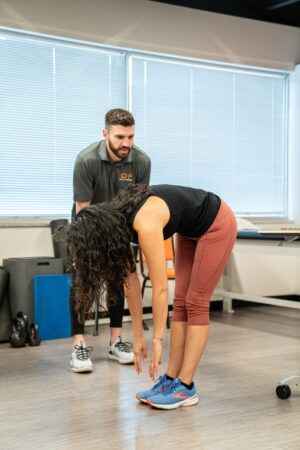This past Saturday, I had the privilege of being the performance physical therapy sponsor at an incredible event to raise funds for breast cancer research—Girls Gone RX, hosted by our friends at Crossfit Route 7 in Tyson’s Corner.
From the moment I stepped through the doors, I could feel the energy. A throwback mix of NSYNC, Backstreet Boys, and Britney Spears filled the air, instantly taking me (and probably many others!) back to the days of Total Request Live on MTV.
But it wasn’t just the music that made this event memorable—there were some amazing takeaways from the competition that can apply to physical therapy, or any sport or workout routine. Here’s what stood out:
The Power of a Supportive Environment
One thing CrossFit does exceptionally well—especially at CrossFit Route 7—is foster a fun, supportive community. It was inspiring to see how excited everyone was to be spending their Saturday at the gym, whether they were competing or cheering on the athletes. The event was a women-only competition, yet both men and women were there in full force, cheering loudly from the sidelines.
The participants ranged from beginners to seasoned athletes. Some were lifting impressive amounts of weight, while others were simply excited to be part of the action. The diversity of skill levels only added to the event’s energy and made it even more inclusive. A supportive environment doesn’t just apply to fitness, it matters in healthcare and physical therapy as well.
Taking Warm-Ups Seriously
These athletes were no strangers to competition, and their warm-up routines showed it. Before each event, competitors spent significant time preparing, but these weren’t your typical, one-size-fits-all warm-ups. The exercises were specifically tailored to the movements required for each event.
For example, before an event involving barbell cleans, the athletes took time to perfect their form, using weights similar to what they’d be competing with. It was impressive to see how much attention was given to detail, and it served as a reminder that a good warm-up should transition you smoothly into your workout. By the time the event began, most of the athletes had already broken a sweat, minimizing the risk of injury.
Master the Basics
Most of the women competing had clearly spent countless hours honing their skills. CrossFit requires a blend of mobility, strength, and technical expertise. It’s tempting to jump straight into the fun aspects of a sport, but this event was a great reminder that you must master the prerequisite qualities of any activity first for long-term success.
Just like building a house, laying a strong foundation is key before adding the finishing touches. Whether you’re a beginner or a seasoned athlete, it’s essential to invest time in developing the movement patterns and technical skills that pave the way for long-term success and injury prevention.
A personalized movement assessment can make all the difference, helping you stay injury-free while enjoying your favorite sport. If you’re interested in learning more about how to get your own custom movement evaluation, contact us!





